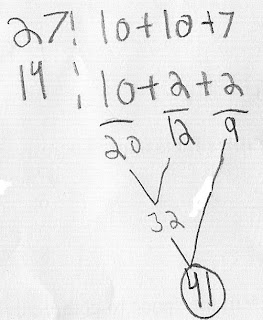FINDING SUMS
Zane's strategy of Decomposing into Tens and One
Zane decomposed 27 into 10+10+7 and 14 into 10+2+2 and then used "left to right" addition to combine each of the partial sums.
Nathan subtracted three from the 14 and added three to the 27 to make a "simpler" problem: 30 + 11. By making the first addend a landmark number (30, a multiple of 10), he created an additon problem that could be solved using "mental math".
Camden begins at 27 on her open number line and then makes a "jump" of 10 to get to 37 (mental math problem), and another "jump" of 4 to get to 41.
With this strategy, Franchesca adds from "right to left". 7 + 4 is one "group of ten" and one "one" (11). Leaving the one "one" in the ones place, she then "regroups" the one group of ten to the tens place and combines it with the 2-tens and 1-ten that are already there.
FINDING DIFFERENCES
Solving 74 - 36
Morgen's use of the Open Number Line for Subtraction 

Morgen starts at 74 on her open number line and subtracts 36 from 74 in five stages: 10, 10, 10, 4, and 2. This moves her back 36 on her open number line. Her ending position (38) on the number line represents the answer to this problem: 74 - 36 = 38.
Tekiyah subtracts six from both the minuend and subtrahend to "make the problem simpler". In subtracting the same amount from both parts of the subtraction problem, the difference (answer) is not changed (since the "distance" between the two numbers on a number line remains the same). 68 - 30 is a "mental math" probem, whereas the original problem 74-36 is not as easily solved without pencil and paper methods.
Eder first decomposes 74 into 70 + 4 and 36 into 30 + 6. He then subtracts his tens (70 - 30 = 40) and then his ones (4 - 6 = -2). Finally, Eder finds the difference in his two partial differences (40 and -2), which is 38.
Caleb subtracted from right-to-left. He decomposed 70 into 60 and 10 so that he could subtract 6 ones from 14 ones to get 8. This left him with subtracting 3 tens from 6 tens to get 3 tens. With regrouping, it is important for students to understand that the original number 74 (70 + 4) is still 74 once regrouping takes place (60 + 14 is STILL 74)- this decomposition of a group of ten to make ten ones simply makes subtracting in the ones place easier so that the result (difference) is NOT a negative number (compare back to Eder's strategy where, without regrouping, a negative number results in the ones place).
MATH ROCKS and so do our kids' strategies! Be sure to leave a comment noting your FAVORITE strategy when combining and comparing numbers.








3 comments:
This strategy work is impressive and shows the depth of knowledge in number sense. Kudos to these kiddos and to our CCE teachers who have instilled this flexibility in thinking at this early age.
I love it that they are taught different strategies to solve the problems. Being able to feel comfortable with a strategy can make the difference between WANTING to solve the problem and thinking they are not able to do it!
thanks, Cathy
You made some good points there. I checked on the net for additional information about the issue and found
most individuals will go along with your views on this web site.
Look into my blog post: stay safe [www.sbwire.com]
Post a Comment